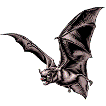Museum, University of Nebraska State

University of Nebraska State Museum: Mammalogy Papers
Cytotypes and Morphometrics of Two Phyllostomatid Bats, Micronycteris hirsuta and Vampyressa pusilla
Document Type
Article
Date of this Version
12-12-1973
Citation
Occasional Papers of the Museum of Texas Tech University (December 12, 1973) number 17, 10 pages.
Abstract
As pointed out by Jackson (1971) and Patton (1972), the key to understanding mechanisms of chromosomal evolution lies in studies of chromosomal variation within populations that can hybridize. Hybrids between cytotypes contain the answer to problems of meiotic pairing and reduced fertility, as well as information concerning the nature of zones of contact. However, before detailed studies can be initiated, chromosomal races and hybrid zones must be located. Few chromosomal races have been described for bats (Baker, 1970a). Within the family Vespertilionidae, five species are known to have such races (Baker, 1970a) and races have been reported in two species of the family Phyllostomatidae.
Described are chromosomal races of two additional species of phyllostomatids (Vampyressa pusilla and Micronycteris hirsuta) and morphological variation associated with these races is discussed.


Comments
Copyright 1973, Texas Tech University. Used by permission.